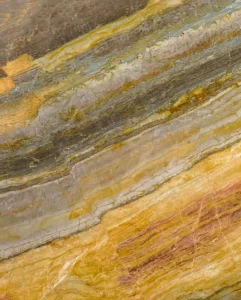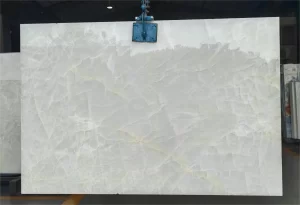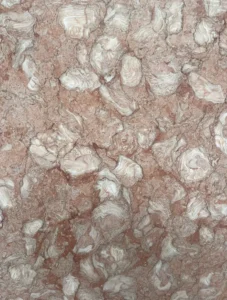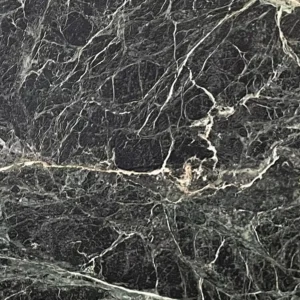Saint Laurent Marble is a high-quality marble known for its dark color and unique appearance. Here is a detailed description of Saint Laurent marble:
Type and Source: Saint Laurent marble is a metamorphic rock and is a natural stone. It forms deep within the Earth’s crust through millions of years of intense heat and pressure. Saint Laurent marble was originally produced in Italy and was named after the French fashion brand Yves Saint Laurent.
Appearance features: Saint Laurent marble is favored for its dark background and unique golden veins. Its base color is usually black or dark gray with bright golden to brown veining. This contrasting color combination gives Saint Laurent marble a noble, luxurious and unique look.
Textures and Patterns: Each piece of Saint Laurent marble has unique textures and patterns, making it a unique stone choice. The golden texture appears on the black background in the form of spots, stripes or clouds, forming a visual layering and artistic sense.
Application areas: Saint Laurent marble is widely used in interior decoration projects, especially those pursuing luxury and refined style. It is commonly used on floors, walls, countertops, vanities, fireplace surrounds, and more. The dark color and unique veins of Saint Laurent marble can bring a noble, luxurious and unique atmosphere to a space.


Maintenance and care: In order to maintain the appearance and luster of Saint Laurent marble, regular cleaning and polishing is necessary. It is recommended to use a mild detergent and a soft cloth for cleaning and avoid using acidic cleaners to prevent damage to the marble surface. During use, avoid cutting or placing overheated objects on the surface to prevent scratches and burns.
Overall, Saint Laurent marble is a high-quality marble distinguished by its dark background and unique golden veins. Its appearance is noble, luxurious and unique, suitable for interior design projects that pursue luxury and refined style. It can be used on floors, walls, countertops, etc. to bring a unique visual effect to the space.
Saint Laurent marble performs well in terms of durability, but its specific durability depends on several factors, including the environment in which it is used and proper maintenance.
Marble, as a natural stone, is relatively hard but can still be subject to wear and scratches. The hardness of Saint Laurent marble can be determined by the Mohs hardness test, and its hardness is generally between 3 and 4. It may be more susceptible to scratches and wear than some harder stones, such as granite.
However, proper care and maintenance can significantly extend the life and appearance of Saint Laurent marble. Here are some recommended maintenance actions:


Regular Cleaning: Clean your Saint Laurent marble surface using a mild detergent and a soft cloth to remove dust, dirt and impurities. Avoid using acidic or abrasive cleaners as they may cause damage to the marble surface.
Avoid scratches: Try to avoid cutting or placing sharp or hard objects on the Saint Laurent marble surface to prevent scratching the surface. Use cutting boards and mats to protect marble surfaces.
Prevent Heat Damage: Avoid placing super hot objects directly on the Saint Laurent marble surface to prevent burns and cracks. Use a heat pad or heat isolator to protect surfaces.
Polish regularly: Polishing regularly can restore the luster of your marble and reduce minor scratches. Consult a professional stone maintenance service for the best polishing method and frequency.
Please note that even durable marble requires proper care to maintain its appearance and performance. Regular maintenance and careful use can extend the life of Saint Laurent marble and ensure its long-term beauty and durability.
When cleaning the surface of Saint Laurent marble, it is best to choose a mild rather than acidic cleaner to avoid damage to the stone surface. Here are a few cleaning options suitable for cleaning Saint Laurent marble:
Neutral detergent: The safest and most common option is to use a neutral detergent, such as one with a pH of 7. This type of cleaner will not cause corrosion or damage to marble surfaces while effectively removing dirt and impurities. Be sure to follow the detergent’s instructions for proper dilution and use.
Mild soapy water: Another gentle cleaning option is to use mild soapy water. You can add a small amount of mild liquid soap to warm water, then dip a soft cloth or sponge into the solution and gently wipe the marble surface.


Specialized stone cleaners: There are also many cleaners on the market that are specifically designed to clean stone. Formulated and tested specifically for stone such as marble, these cleaners safely clean and protect stone surfaces. Follow the instructions for your cleaner and be sure to choose a product that is compatible with Saint Laurent marble.
No matter which cleaner you choose, you should follow these steps:
Start by dampening a soft cloth or sponge with the detergent solution.
Gently wipe the marble surface, making sure to cover the entire area.
If there is stubborn dirt, you can wipe it with a little force, but avoid using cleaners or brushes with abrasive particles.
Rinse the surface thoroughly with clean water to ensure that detergent residue is completely removed.
Gently dry the surface with a clean, soft cloth or rag.
Please note that before using any cleaner, it is best to test it by applying it to an inconspicuous area to ensure it does not cause any adverse reactions to the marble surface. If you’re not sure how to clean Saint Laurent marble, consult a professional stone maintenance service or ask your supplier for advice.
It’s wise to conduct tests to determine if a cleaner is causing any adverse reactions to your marble surface. Here’s a simple way to test the effect of cleaners on Saint Laurent Marble:
Choose an inconspicuous area: Choose an area that is less visible in everyday use, such as a corner or a small area under the floor. Make sure the area is part of Saint Laurent marble to ensure the test results are accurate.
Dilute the cleaner: Follow the cleaner’s instructions and dilute it to the appropriate concentration. If the cleaner is to be used locally, this step can be skipped.
To test: Apply diluted cleaner to selected test area. Using a soft cloth or sponge, dab the cleaner in, making sure to cover the entire area. It is recommended to use the same wiping time and intensity for comparison.
Observe the results: Let the cleaner sit on the test area for a while, 10 to 15 minutes is usually recommended. Then, rinse away the detergent residue thoroughly with clean water. Observe the test area carefully and note any adverse reactions such as color changes, fading, changes in brightness, spots, or surface roughness.
Compare to untreated area: Compare the test area to a nearby untreated area. If no adverse reactions occur in the test area and there are no noticeable differences compared to untreated areas, the cleaner is probably safe. If adverse reactions or noticeable differences occur, avoid using the cleaner on the entire marble surface.
Keep in mind that each type of marble may have different characteristics and response to cleaning agents. Therefore, before using a new cleaner, it is always best to test it to make sure it will not cause any adverse effects on the marble surface. If you are unsure or have any questions about the test results, it is recommended to consult a professional stone maintenance service or seek advice from your supplier.





